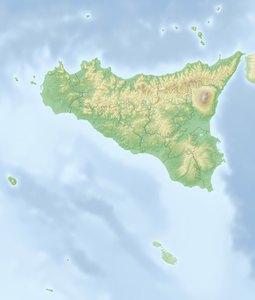Colombaia
| Colombaia | ||
|---|---|---|
| Location Colombaias off the western tip of Sicily | ||
| Waters | Tyrrhenian Sea | |
| Geographical location | 38 ° 0 ′ 41 " N , 12 ° 29 ′ 36" E | |
|
|
||
| length | 700 m | |
| width | 60 m | |
| Residents | uninhabited | |
Colombaia is the name of a small rock island in front of the port entrance of the Sicilian city of Trapani . Already in ancient times the island was built to protect the harbor, the 32 meter high Torre Peliade or Torre Colombaia (with extensions also Castello Colombaia ) is one of the sights of the city.
Location and geology
The island stretches for almost 700 meters in a westerly direction, is around 60 meters wide and rises up to 3.50 meters slm. To protect the harbor, a 700-meter-long pier extends southwards at its eastern end , a nearly 300 meters long, smaller breakwater seals off the passage between the island and the western headland of Trapani. The shortest distance to the islet of Sant'Antonio, which is now connected to the mainland, is around 200 meters on the eastern edge of Colombia; to the west, after around 30 meters, is the small rocky island of Scoglio Palumbo , which today has a lighthouse.
The island consists of biogenic limestone , in which the remains of numerous fossils such as mussels , echinites , nummulites , algae , corals , miogypsins and assilins can be found.
history
The island was of considerable strategic importance even in ancient times. According to a legend, fleeing Trojans are said to have built the first fortification on the island (the grave of Anchises was believed to be a few kilometers further north on the coast). A Carthaginian fortress is more likely , which was presumably built on the orders of Hamilkar Barkas during the First Punic War . The ancient name of the island was Pelias.
For the Romans, the consul Numerius Fabius Buteo conquered the island and Trapani in a single night. During the time of the Roman Empire, the fortification lost its function and fell into disrepair. The current name of the island comes from the pigeons (ital. Colomba ) living in it , which, according to a French report, stopped here on the flight to Africa and were possibly worshiped as sacred animals of Venus de Erice .
Nothing is known about the island for the next few centuries. What is certain is that the Arabs again built a fortification on the rock during their rule. The octagonal, 32 meter high tower probably dates from this period. It has four floors, with the original entrance on the second floor, while the one below was used as a cistern.
In 1360, the future Sicilian Queen Konstanze was on the way to her wedding with Friedrich III. Detained on the island for three days because Count Guido of Ventimiglia feared that he would lose control of the Trapani prefecture because of her.
King Martin I had a landing stage built for the arrival of his bride, Maria of Sicily , and from 1408 the castle was expanded under his rule. Ferrante I Gonzaga commissioned Charles V to carry out further modifications . The necessary money for an extension of the fort and the rest of the fortifications of Trapani, which was appropriate to the defense technology of the time, flowed slowly, however, several submissions from the council of the city, fearful of pirate attacks, to the Sicilian viceroy were necessary before money for the extension was approved. In the middle of the 16th century, Trapani became a supply base for the Spanish-southern Italian garrisons, which required further expansion of the fortifications: in 1586 another renovation was carried out according to plans by the military architect Camillo Camilliani , the last one was carried out around 1670 for the Sicilian viceroy Don Claudio Lamoraldo, Prince Ligné . A Latin inscription carved in stone attests to this last expansion. From 1821 the castle served as a prison, between 1849 and 1860 some followers of the Risorgimento were imprisoned here, among them Michele Fardella di Mokarta. From 1855 to the beginning of the 20th century the tower of the fort was used as a lighthouse.
In 1965 the island and the fort were completely abandoned and left to decay, in 1993 they were restored by the architects Filippo Terranova and Giovanni Vultaggio. There are discussions about re-using the building as a museum, but it is currently not open to the public.
literature
- Alberto Costantino: La Colombaia. Una storia bimillenaria: immagini e cartography. CSR, Trapani 1996.
Web links
- Detailed information on colombaiatrapani.altervista.org (ital.)
- Private page about Colombaia (ital.)
- Presentation on the website of the municipality of Trapani (ital.)
Individual evidence
- ↑ Description on castellammaredelgolfo.com ( Memento of the original from July 8, 2008 in the Internet Archive ) Info: The archive link has been inserted automatically and has not yet been checked. Please check the original and archive link according to the instructions and then remove this notice.
- ↑ Images of the lighthouse on the pages of the Italian Navy (ital.)
- ^ Russ Rowlett: Lighthouses of Italy: Eastern Sicily ( English ) In: The Lighthouse Directory . University of North Carolina at Chapel Hill . Retrieved September 17, 2011.



